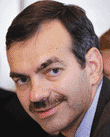'Dramatic mind shift' moves e-gov forward

Mark Forman, administrator of e-government and information technology in the Office of Management and Budget, recently spoke with Staff Writer Gail Repsher Emery about e-gov.
Mark Forman, administrator of e-government and information technology in the Office of Management and Budget, recently spoke with Staff Writer Gail Repsher Emery about e-gov. Has progress on OMB's 25 e-gov initiatives spurred demand for more e-gov efforts? There is a clear increase in citizen-facing e-initiatives, and a clear increase in the use of e-business and collaborative tools. Part of it is the President's Management Agenda focus on the citizen. Part of it is we are nearing the Government Paperwork Reduction Act deadline, and part of it is the business value -- the efficiency or effectiveness gains that industry is able to communicate better, and agencies are better able to understand.Last summer was the beginning of a dramatic mind shift where people started seeing that IT and business process improvement went together. What e-gov opportunities will be forthcoming?We continue to focus on the [existing] initiatives. Next year is the migration [of agency-specific solutions to cross-agency e-government solutions]. One-third of the functions of government have heavy redundancy. We're [also] focusing on [reducing redundancy in] six lines of business [criminal investigations, data and statistics, financial management, human resources, monetary benefits and public health monitoring]. We just completed an opportunity assessment and will move into business cases for some of those opportunities. Has congressional oversight of e-gov changed in the last year? There's been a lot more interest in specific initiatives. In the past, there was a lot of discussion about should we have a chief information officer, who should the CIO report to, we need to do more in e-gov. It's gotten a lot more sophisticated. There are more people in the House engaged in the details of e-gov. [Reps. Tom] Davis and [William "Lacy"] Clay have been truly engaged. It is definitely good for the President's Management Agenda. In the Senate, [Joseph] Lieberman continues to be interested in it. But I have not seen interest growing in the same way in the Senate. Your April e-gov strategy report cited issues such as parochialism and lack of funding as barriers to e-gov progress. What has been done to overcome those problems? We all wish there was a big pot of money on the one hand; on the other hand, we hope agencies would join together on projects that meet their needs. We've had to do that by orchestrating [memoranda of understanding] where agencies join together to commit to funding and results that are useful to the agencies.Some of the cultural barriers are human nature, and probably won't go away, meaning that people are loyal to the agency they work for. It's hard to be loyal to a cross-agency project. Have you changed your approach to get buy-in to cross-agency projects? We've restructured the CIO Council to be much more of a governing body to address problems as opposed to just sharing insight. The architecture committee can now make decisions on joint IT solutions. The work-force committee enabled us to close the gap on project managers across government ? sharing training slots with agencies that need training but not enough to justify a new course, and sharing project managers on a case-by-case basis. That never happened before. How would you rate the success of your simplify and unify agenda? We are doing pretty well on unifying. People are thinking that way, but we aren't really seeing the savings from consolidation [of systems]. There were some budget requests denied in the fiscal 2004 budget process, but cost avoidance is not the same as savings. By next summer, we ought to be able to document that we are going to be able to turn back money [to the taxpayers]. On the simplify side, just look at the traffic at FirstGov or any of the simplified Web sites. The numbers are higher than I anticipated. [In 2001], 7 million people visited FirstGov. Last year, with three clicks to service, 37 million people visited. This year, we are seeing 6 million visitors a month. That puts us on track for 70 million visitors this year. We can realistically talk about e-government delivering better service to millions of people. What makes an e-gov initiative successful? Good program management. The magnitude of business process change. The more work there is, the longer it has taken us. Having an engaged leader at the highest level of the organization, generally a deputy secretary. It's very hard to do a leadership initiative unless all the leaders are fully engaged.

WT:
Forman:
WT:
Forman:
WT:
Forman:
WT:
Forman:
WT:
Forman:
WT:
Forman:
WT:
Forman:

Washington Technology Staff Writer Gail Repsher Emery will host a live Web forum on e-gov with OMB's Mark Forman on Tuesday, July 22, at noon eastern. Details
WT file photo
WT:
Forman:
WT:
Forman:
WT:
Forman:
WT:
Forman:
WT:
Forman:
WT:
Forman:
WT:
Forman:
NEXT STORY: Special Report: E-Gov under construction